
As our cats age, it’s important to make small changes around our home to make them more comfortable and their home easily accessible, and that includes the litter box. If your kitty seems to be struggling to access their high-sided or enclosed litter box, it may be time to explore some more age-appropriate options. Read on to find our reviews on various senior cat litter box solutions and a handy buying guide to help you understand your aging cat’s toileting needs.
A Quick Comparison of Our Favorites in 2024
| Image | Product | Details | ||
|---|---|---|---|---|
| Best Overall |

|
KittyGoHere Senior Cat Litter Box |
|
CHECK PRICE |
| Best Value |

|
Van Ness Large Framed Cat Litter Pan |
|
CHECK PRICE |
| Premium Choice |

|
Shirley K's Senior Cat Litter Box |
|
CHECK PRICE |

|
Petmate Litter Pan |
|
CHECK PRICE | |

|
Frisco Senior and Kitten Cat Litter Box |
|
CHECK PRICE |
The 10 Senior Litter Box Solutions
1. KittyGoHere Senior Cat Litter Box – Best Overall
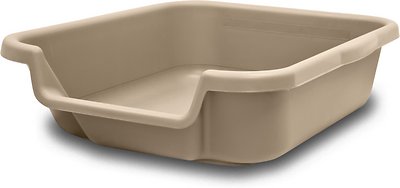
| Weight: | 4 pounds |
| Dimensions: | 24”L x 20”W x 5”H |
| Entry Height: | 3 inches |
| Material: | Plastic |
The KittyGoHere Senior Cat Litter Box is designed with senior cats in mind. This super short litter pan boasts an entryway of just three inches, making it a fantastic litter box for arthritic cats, as they won’t even need to jump to get inside the box. Even the higher sides are just five inches tall, so if your kitty chooses to use an entry point other than the designated entrance, they shouldn’t have any problems getting in and out of their box. For these reasons, we believe this to be the best senior cat litter box solution on the market. These boxes come in one of three colors and two sizes, though they aren’t necessarily priced for the budget-conscious cat owner.
- Three-inch high entry is easy to access
- Easy to get in and out of regardless of entry point
- No need to jump into the box
- Available in two sizes
- Comes in three color options
- High price tag
2. Van Ness Large Framed Cat Litter Pan – Best Value
| Weight: | N/A |
| Dimensions: | 19”L x 15”W x 7.5”W |
| Entry Height: | 4 inches |
| Material: | Plastic |
The Van Ness Large Framed Cat Litter Pan is an extremely affordable solution for owners looking for the best senior cat litter box solutions for the money. The framed pan is great for older cats who don’t have the dexterity to squat to pee or poop like they used to. It provides added height, reducing urine spillage as well as litter spills from kitties who are a bit too exuberant when they cover their waste. The entry point is just four inches, making it possible for seniors to enter without having to jump and hurt their joints. Additionally, the frame is useful for holding pan liners in place if you choose to use them.
The litter pan itself is rather small, so it may not be ideal for larger cats or multi-pet households. Be sure to check the dimensions before deciding if this is the right solution for you.
- Low entry point
- Frame provides protection from urine spray and litter scatter
- Holds pan liners in place well
- Affordable price
- Box is small, not ideal for larger breeds
3. Shirley K’s Senior Cat Litter Box – Premium Choice
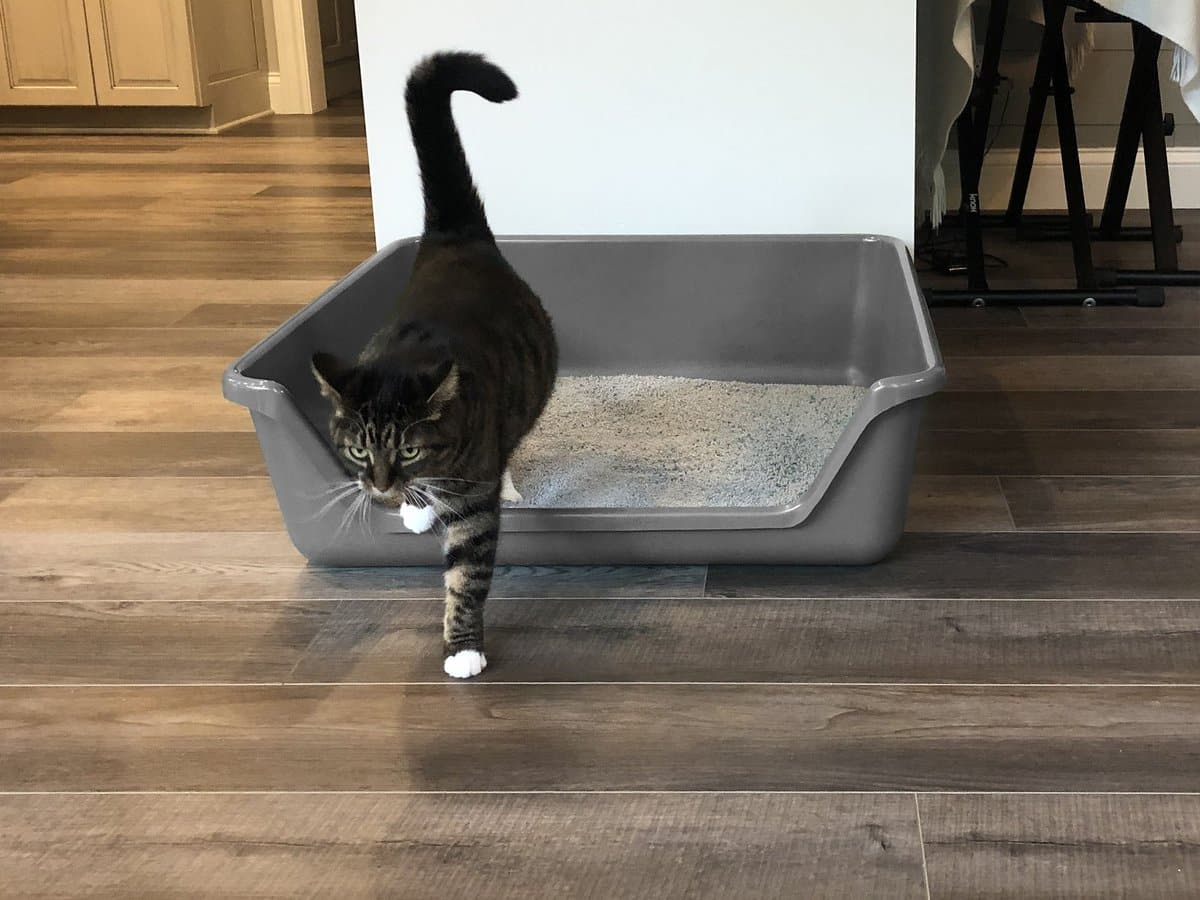
| Weight: | 5 pounds |
| Dimensions: | 30”L x 30”W x 9”H |
| Entry Height: | 5 inches |
| Material: | Plastic |
Shirley K’s Senior Cat Litter Box won’t suit every budget, but it is worth considering splurging on if you can swing it. At 30 inches by 30 inches, this litter box is huge, making it ideal for multi-cat households or large kitties. Its entry height is just 3.5 inches, eliminating the need to jump into the box to use it. The other three sides are 9 inches high to help reduce litter scatter and urine spillage. The surface is smooth and non-porous to provide a sanitary space for your kitty to do their business.
As mentioned, this litter box is very large. We highly recommend you use a measuring tape to determine if this will fit in the space you have intended it for. It requires a fair amount of litter to fill and may be too heavy for some folks to deal with.
- Large size is good for bigger cats
- Short entryway
- Higher sides to prevent litter scatter
- Non-porous and smooth surface
- Expensive
- Heavy
4. Petmate Litter Pan

| Weight: | N/A |
| Dimensions: | 55”L x 15.35”W x 5”H |
| Entry Height: | 5 inches |
| Material: | Plastic |
It doesn’t get much simpler than the affordably priced Petmate Litter Pan. Though this box doesn’t have a dropped entryway, it is just five inches high, which can be perfectly acceptable for some senior cats to use without issue. This sturdy pan has a large base that provides extra stability. It’s made with Microban-infused plastic to prevent the growth of microbes responsible for staining, odors, and product degradation. It comes in two sizes: large (dimensions listed above) and jumbo.
Pay close attention and use your measuring tape to ensure you get the size best suited for your needs. The “large” size is quite small and may not be appropriate for all cats.
- Low profile box makes for easy access
- Microban-infused plastic prevents microbialgrowth
- Comes in two size options
- Affordable price
- “Large” size may not be big enough
5. Frisco Senior and Kitten Cat Litter Box
| Weight: | 2 pounds |
| Dimensions: | 24”L x 20”W x 5”H |
| Entry Height: | 3 inches |
| Material: | Polypropylene |
The Frisco Senior and Kitten Cat Litter Box is designed specifically with older (and very young) cats in mind. This sturdy and lightweight box boasts a short 3-inch entryway, perfect for your senior cat who doesn’t get around like they used to. The remaining sides are just five inches high, so even if they don’t like using the designated entrance, exiting and entering the box should be a breeze for most cats. It’s made with a sturdy and lightweight polypropylene plastic that’s easy to keep clean with soap and water.
The downside to any low-sided litter box is that it’s easy for cats to pee outside of the box accidentally if they can’t squat like they used to.
- Low entry point
- Low sides all around
- Sturdy materials
- Easy to clean
- Low sides all around can cause messes
6. Richell PAW TRAX High Wall Cat Litter Box
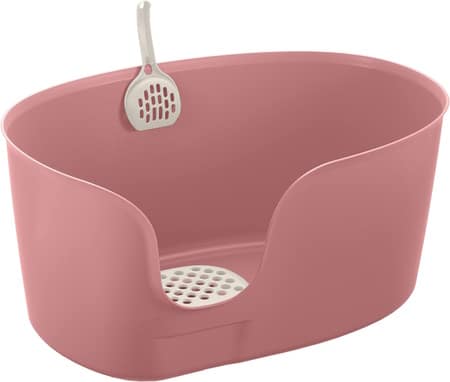
| Weight: | N/A |
| Dimensions: | 27”L x 18”W x 12.5”H |
| Entry Height: | 5 inches |
| Material: | Plastic |
The Richell PAW TRAX High Wall Cat Litter Box is the perfect solution for cat owners whose pets get crazy when they’re covering their pee or poop. At over one foot high, this box has extremely high sides to prevent litter scatter as well as urine spillage. Its dropped entry point is five inches, which should be accessible enough for most senior kitties. This extra-large box is great for big cats and multi-pet homes. Its anti-tracking gate is meant to assist in litter removal as your kitty leaves the box, ensuring fewer particles get scattered throughout your home, though it is extremely difficult to keep clean.
This litter box is quite expensive.
- High sides to prevent accidents and litter scatter
- Plenty of interior space
- Low entry point for easy accessibility
- Good for big cats and multi-cat homes
- Anti-tracking gate can be hard to keep clean
- High price
7. Frisco Stainless Steel Cat Litter Box
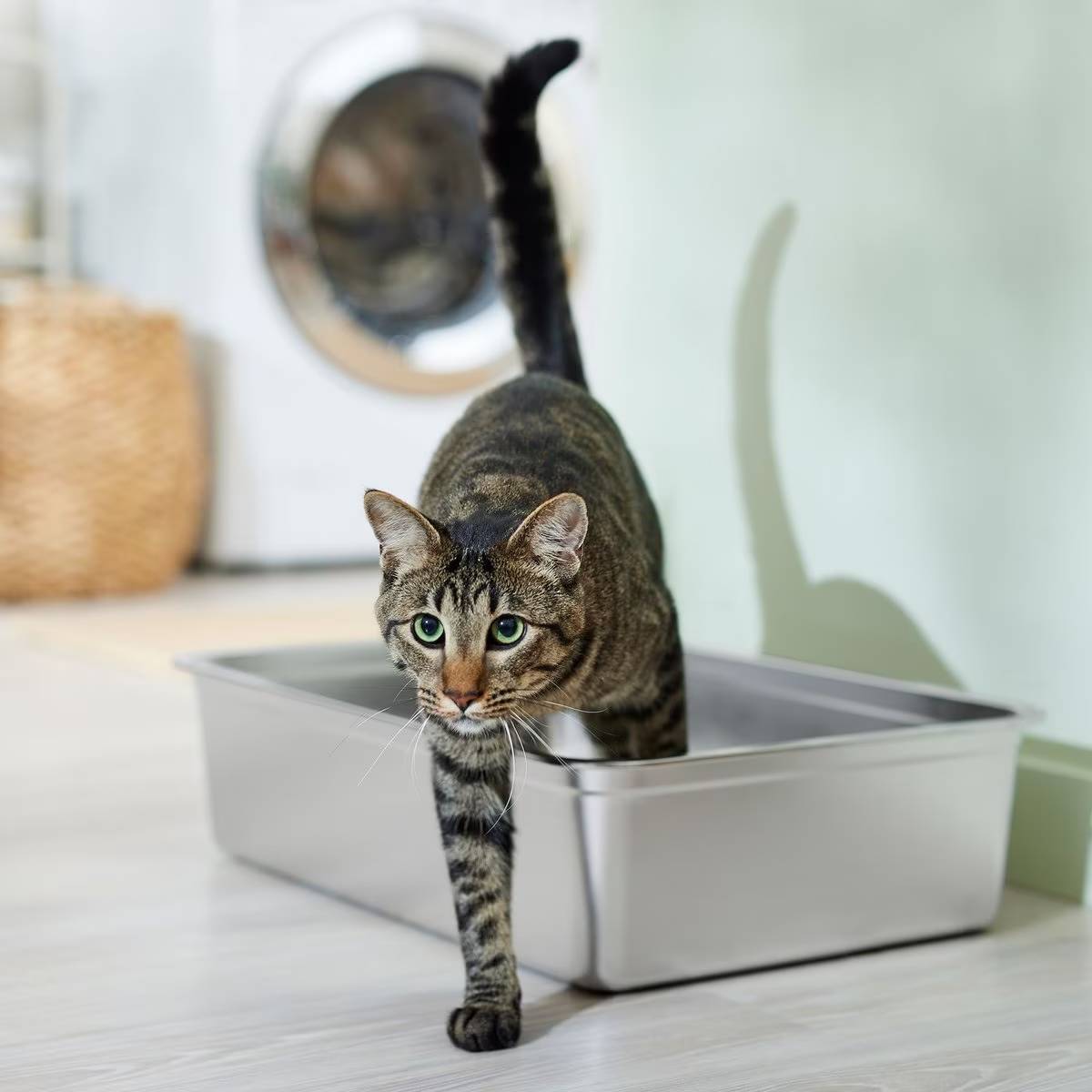
| Weight: | 51 pounds |
| Dimensions: | 4”L x 15.5”W x 5.9”H |
| Entry Height: | 9 inches |
| Material: | Stainless steel |
Though the Frisco Stainless Steel Cat Litter Box has slightly higher sides than other options we’re reviewing today, we still felt this product is worth considering for senior cats that are still quite agile. The stainless-steel construction makes this box extremely hygienic, durable, sturdy, and resistant to cracking. Additionally, the slippery material means it is very easy to clean. There’s plenty of interior space in the box for your kitty to move around, and its higher sides mean less chance of litter scatter or urine spillage.
The manufacturer has placed a label on the interior of the pan, which is very difficult to remove. Additionally, the edges can be sharp in some areas, which can be a hazard for you when you go to clean the box.
- Hygienic construction
- Easy to clean
- Plenty of interior space
- Higher sides mean less litter scatter
- Label is hard to get off
- Sharp edges
8. Booda Dome Cleanstep Litter Box
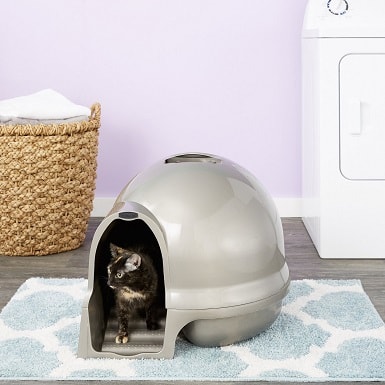
| Weight: | N/A |
| Dimensions: | 5”L x 22.5”W x 19”H |
| Entry Height: | Gradual |
| Material: | Plastic |
Senior cats often benefit from the installation of ramps around the home to help them get around more easily. If you have a ramp to help them get onto your bed or sofa, why not consider a litter box with a built-in ramp to help them do their business more comfortably? The Booda Dome Cleanstep Litter Box is a covered litter box solution that provides your kitty with the privacy they may need to do their business. It has a built-in handle to make moving it a breeze and a carbon filter on top to help cut back on unpleasant odors.
There is no latch to keep the lid on the box, which can be bothersome for particularly mischievous kitties. The box itself is quite large, and its rounded design may make finding the perfect spot for it in your home difficult. Additionally, it is worth noting that there is no ramp from the litter box to the stairway, so your kitty will need to be comfortable making small steps to exit their box.
- Ramp for easy access into the box
- Covered style for privacy
- Built-in handles to move it easily
- Cabron filter resists odors
- Awkward shape
- No ramp leading from the litter box
- No latch to keep the lid on and secure
9. Green Lifestyle Reusable Cat & Dog Pee Pads

| Weight: | N/A |
| Dimensions: | 34” x 36” or 30” x 34” |
| Entry Height: | Not applicable |
| Material: | N/A |
While pee pads aren’t a perfect solution for dealing with your cat’s incontinence issues, they work for some cats. The Green Lifestyle Reusable Cat & Dog Pee Pads are available in several sizes and quantities to suit your needs. These thick and large pads have a waterproof backing to lock in moisture and prevent leaks. They are designed to be tossed in the washer when dirty, so you can reuse them over and over, providing more bang for your buck. The pee pads are available in two size options, in packs of 4 or 6.
The pads are simple to clean, but they do stain easily. The additional benefit of using reusable pads for cats is that most of the time, despite thorough laundering, fabric tends to retain traces of feline urine odor. This is why it can be so difficult to get cats to stop urinating in certain places in the house, but in this instance, can actually be beneficial in helping your cat continue to recognize the pad as a toilet.
- Absorbent
- Waterproof backing to prevent leaks
- Machine washable
- Two size options are available
- More eco-friendly than disposable pads
- Pads don’t come clean easily
- Some cats won’t take to them
10. Four Paws Wee-Wee Superior Performance Dog Pee Pads

| Weight: | 5 pounds |
| Dimensions: | 16”L x 12”W x 8.5”W |
| Entry Height: | Not applicable |
| Material: | Cotton, natural fabric |
While using pee pads is certainly not ideal, they’re better than allowing your kitty to do their business on your floor or carpet. The Four Paws Wee-Wee Superior Performance Dog Pee Pads are made with six layers to ensure a leakproof system to protect the surfaces of your home that your senior cat is peeing on. Each layer has its own job, such as distributing fluids evenly, locking in moisture, and drawing fluid to the pads’ core. The quick dry top layer has oversized quilting to reduce the likelihood of your cat leaving wet paw tracks throughout your home.
The pads do not have odor-blocking agents, so they provide nothing in the way of odor absorbency. Additionally, because they’re meant to be used only once, they can become quite pricey over time.
- Leakproof and absorbent
- Quick drying top layer
- Easy clean up
- No odor-blocking agents
- Pricey
- Can only be used once
Buyer’s Guide: How to Find the Best Litter Box for Senior Cats
Making Your Senior Cat’s Toileting Duties
More Comfortable
When your cat gets older, things that they used to do without a second thought, such as jumping onto your bed or traversing to the tippy top of their cat tree, can become more difficult. The same will apply to their litter box habits. While they once found it easy to hop into your high-sided litter box without abandon, they may not be able to do so when their joints are sore or arthritis has set in. The following tips will help you choose the right litter box for an elderly cat to ensure they can continue their healthy toileting habits well into their golden years.
Opt for a Dropped Entry
Dropped entry litter boxes have very short entry points that make it easier for senior cats to enter and exit. The entryways should be around five inches to ensure your cat can walk into the box instead of jumping into it. These models can still have other useful features, such as high sides, but they should be considered secondary to the features included to improve your senior pet’s comfort.

Choose a Shallow Box
Sometimes, choosing a dropped entry litter box isn’t enough for a senior cat, especially if the rest of the box is higher than the entry point. Cats are smart, but they may not realize they’re supposed to enter and exit at the shortest point of the box. Enter shallow boxes.
Shallow boxes are shorter all around, making entering and exiting a no-brainer for your senior guy or gal.
Add An Extra Box or Two
Senior cats may lose bladder tone as they age, making it hard for them to “hold it” until they’ve reached their box. Make accidents less common by placing additional litter boxes in easy-to-access places in your home. For example, if your cat spends a lot of their time on your sofa, but the nearest litter box is across the house in your laundry room, consider placing one in your living room. You can find really nicely designed litter boxes that double as furniture pieces to “hide” the fact that your cat’s toilet is in the middle of your living room.
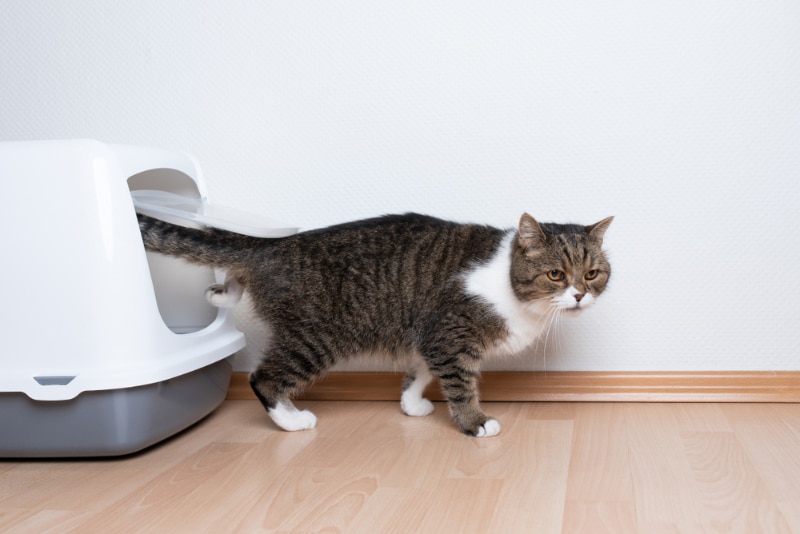
Invest in Litter Mats
The downside to having a shallow litter box is that it’s easier for litter to scatter throughout your home. A litter mat won’t catch all the particles, but it certainly can help grab some of the excess litter before it makes its way to every nook and cranny in your home. Opt for the biggest size you can manage for your space to increase its surface area and grab more litter.
What if My Cat Refuses to Use Their New Litter Box?
If your cat is refusing to even look at their new litter box, a visit to the vet should be to rule out any potential health conditions causing them to eliminate inappropriately around your home. Talk to your vet about pain relief options to make sure your elderly feline is able to enjoy their twilight years in comfort. If they receive a clean bill of health from the vet, there are other things you can do to make your litter box more welcoming for your senior:
- Consider placement. Is the litter box in a spot your cat is familiar with? Make sure it’s easy to access (e.g., not in the basement if your catis struggling with stairs) and on a flat, stable surface.
- Clean daily. Clean your litter boxes at least once daily, preferably more if you can swing it. Cats are notoriously fastidious creatures and prefer using clean facilities over ones that have been soiled in several times already.
- Use a cat litter mat. Put the litter box on top of a mat to provide a durable and soft surface for entry and exit. Hardwood floors are especially difficult for some senior cats to navigate as they don’t provide the traction they need to get in and out of the box.
Is It Sanitary for My Cat to Use Pee Pads?
Pee pads aren’t an ideal solution for your senior cat’s aversion to the litter box, but they certainly beat having to deal with cat urine and poop all over your flooring. High-quality pee pads have fantastic absorbency and odor control and won’t be as unsanitary as you might initially think.
There is a bit of learning involved with transitioning your cat from a litter box to pee pads. Here are some tips on how to do so with as few accidents as possible.
- Don’t ditch the litter box yet. If your senior cat has been using a litter box their whole life up until this point, they’ll likely associate their litter box with the place they should be going to the bathroom. To begin transitioning them to pee pads, place the pad inside of a clean litter box flat on the bottom. It should be big enough to drape over the sides of your box, and if all goes according to plan, your kitty will be on it out of habit.
- Put litter on the pee pad. This isn’t a permanent solution, but instead, it is something to help your litter box-trained kitty associate the pee pad with their new place to pee. Put a small amount of litter in the middle of the pad to help clue them in. Once they start using the pad consistently, less and less litter can be used until none is necessary at all.
- Be strategic with placement. If your cat is currently not using a litter box at all, place the pee pad where they’re doing their business most often.
- Put something under the pee pad. Though pee pads should be leakproof and absorbent, poorer quality options on the market may still leak through. To save the integrity of your flooring, you may consider placing your pee pads on top of something like a cookie sheet or waterproof mat.
Tips for Cleaning Up Cat Urine
Several factors relating to your pet’s aging can result in litter box misses and accidents. Let’s take a closer look at how to clean up cat urine properly.
Follow the Right Steps
As soon as you’ve found the urine stain, blot up as much as you can with a clean cloth or rag. Then, rinse the area with clean water. Use a wet/dry vacuum to remove excess liquid from the area. Do not use a steam cleaner, as the high heat can set the stain, making it nearly impossible to get rid of. Next, soak the spot in the right cleaner (see tips below) and allow it to sit on the stain for several minutes before blotting it with another clean cloth. You may need to repeat these steps one or two more times until the stain and scent are both gone.
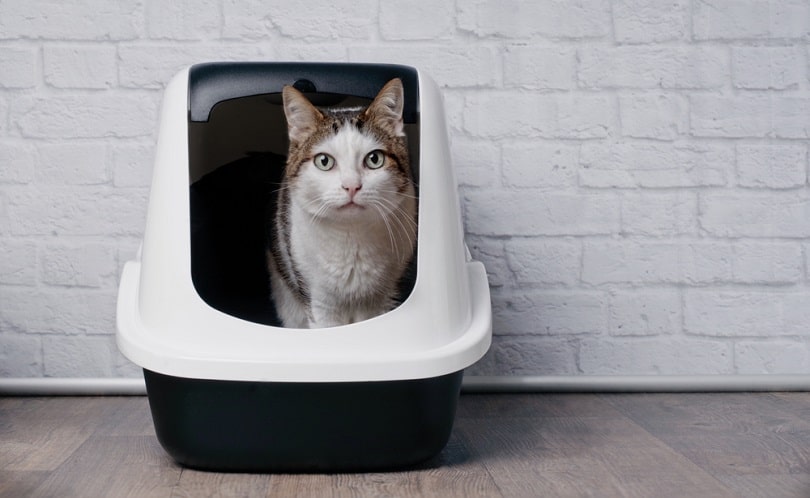
Use the Right Cleaners
When it comes to cleaning cat urine, know that not every cleaner or disinfectant will work the way you want it to. Enzymatic-based cleaners are absolutely going to be your best friend if your kitty is having toileting problems, especially if the messes are in carpets, linens, or couch cushions. These products contain enzymes that work to break down the acid in urine, getting rid of the smell at the same time it cleans it up. It’s especially important when cleaning cat pee to ensure you’ve cleaned it to the point where your cat can no longer smell it. If your cat can smell a previous accident, they’re more likely to use that spot again in the future.
You can also try white vinegar to neutralize the alkaline salts found in dried urine. Use one part water and one part vinegar to clean urine-stained walls and floors.
Be Patient
As frustrating as it can be to deal with these messes and awful smells, it’s important to remember to be patient with your pet. The last thing you want to do is yell at them or physically punish them, as doing so can ruin the beautiful bond you’ve spent years cultivating. Plus, the added stress can just make the problem worse. Instead, put on your sterile gloves and get to work cleaning up the mess. The less time it spends on the floor or carpet, the easier it’ll be to clean.
Conclusion
The best overall senior cat litter box solution is the KittyGoHere, as it was made specifically with older cats’ needs in mind. Its short sides ensure your kitty can enter and exit with ease. If you’re on a strict budget, the Van Ness litter pan is a good option for its low price and short entryway.
As our kitties age, we must ensure they can access what they need to stay comfortable, happy, and sanitary. Our reviews above are a great jumping-off point for you as you search for solutions to make your senior cat’s toileting habits a little easier and more accessible.
Featured Image Credit: Lightspruch, Shutterstock
Contents
- A Quick Comparison of Our Favorites in 2024
- The 10 Senior Litter Box Solutions
- 1. KittyGoHere Senior Cat Litter Box – Best Overall
- 2. Van Ness Large Framed Cat Litter Pan – Best Value
- 3. Shirley K’s Senior Cat Litter Box – Premium Choice
- 4. Petmate Litter Pan
- 5. Frisco Senior and Kitten Cat Litter Box
- 6. Richell PAW TRAX High Wall Cat Litter Box
- 7. Frisco Stainless Steel Cat Litter Box
- 8. Booda Dome Cleanstep Litter Box
- 9. Green Lifestyle Reusable Cat & Dog Pee Pads
- 10. Four Paws Wee-Wee Superior Performance Dog Pee Pads
- Buyer’s Guide: How to Find the Best Litter Box for Senior Cats
- Making Your Senior Cat’s Toileting Duties
- More Comfortable
- Opt for a Dropped Entry
- Choose a Shallow Box
- Add An Extra Box or Two
- Invest in Litter Mats
- What if My Cat Refuses to Use Their New Litter Box?
- Is It Sanitary for My Cat to Use Pee Pads?
- Conclusion















